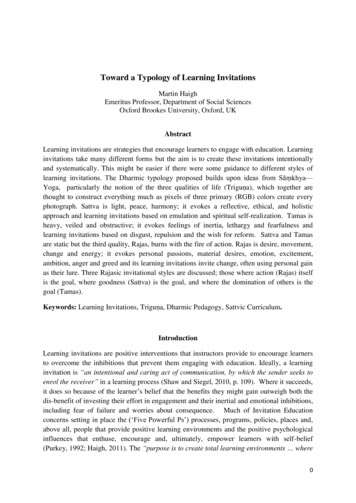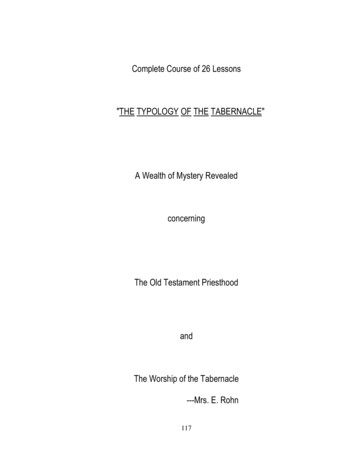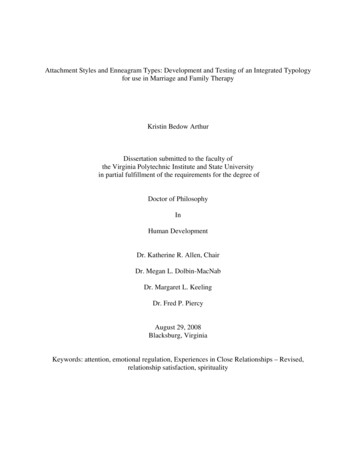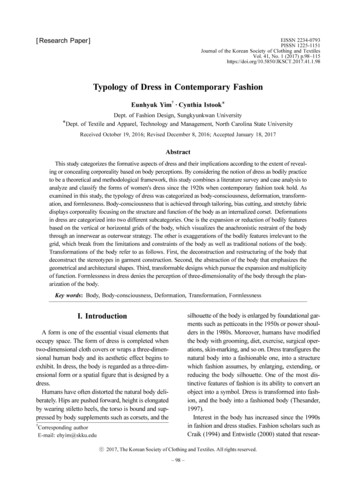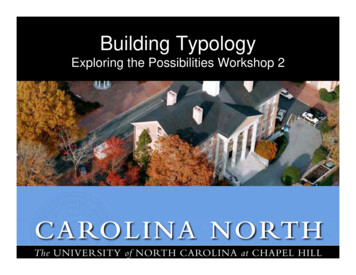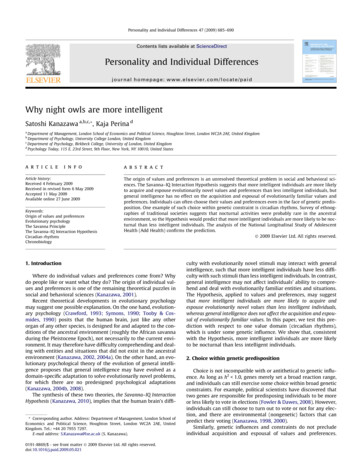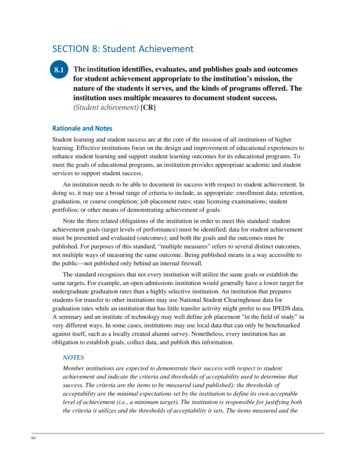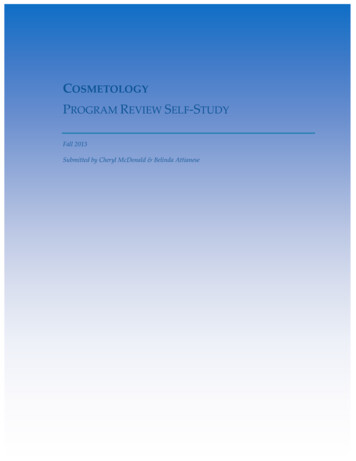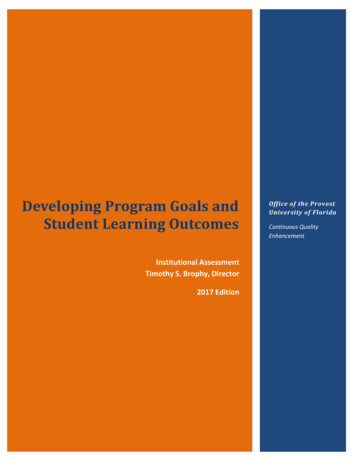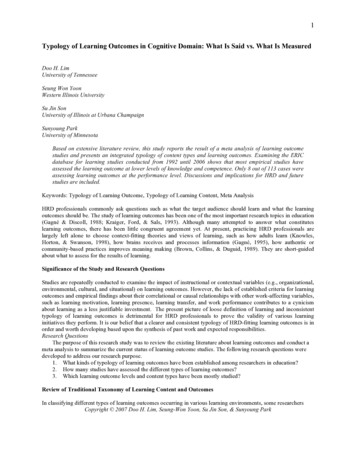
Transcription
1Typology of Learning Outcomes in Cognitive Domain: What Is Said vs. What Is MeasuredDoo H. LimUniversity of TennesseeSeung Won YoonWestern Illinois UniversitySu Jin SonUniversity of Illinois at Urbana ChampaignSunyoung ParkUniversity of MinnesotaBased on extensive literature review, this study reports the result of a meta analysis of learning outcomestudies and presents an integrated typology of content types and learning outcomes. Examining the ERICdatabase for learning studies conducted from 1992 until 2006 shows that most empirical studies haveassessed the learning outcome at lower levels of knowledge and competence. Only 8 out of 113 cases wereassessing learning outcomes at the performance level. Discussions and implications for HRD and futurestudies are included.Keywords: Typology of Learning Outcome, Typology of Learning Content, Meta AnalysisHRD professionals commonly ask questions such as what the target audience should learn and what the learningoutcomes should be. The study of learning outcomes has been one of the most important research topics in education(Gagné & Discoll, 1988; Kraiger, Ford, & Sals, 1993). Although many attempted to answer what constituteslearning outcomes, there has been little congruent agreement yet. At present, practicing HRD professionals arelargely left alone to choose context-fitting theories and views of learning, such as how adults learn (Knowles,Horton, & Swanson, 1998), how brains receives and processes information (Gagné, 1995), how authentic orcommunity-based practices improves meaning making (Brown, Collins, & Duguid, 1989). They are short-guidedabout what to assess for the results of learning.Significance of the Study and Research QuestionsStudies are repeatedly conducted to examine the impact of instructional or contextual variables (e.g., organizational,environmental, cultural, and situational) on learning outcomes. However, the lack of established criteria for learningoutcomes and empirical findings about their correlational or causal relationships with other work-affecting variables,such as learning motivation, learning presence, learning transfer, and work performance contributes to a cynicismabout learning as a less justifiable investment. The present picture of loose definition of learning and inconsistenttypology of learning outcomes is detrimental for HRD professionals to prove the validity of various learninginitiatives they perform. It is our belief that a clearer and consistent typology of HRD-fitting learning outcomes is inorder and worth developing based upon the synthesis of past work and expected responsibilities.Research QuestionsThe purpose of this research study was to review the existing literature about learning outcomes and conduct ameta analysis to summarize the current status of learning outcome studies. The following research questions weredeveloped to address our research purpose.1. What kinds of typology of learning outcomes have been established among researchers in education?2. How many studies have assessed the different types of learning outcomes?3. Which learning outcome levels and content types have been mostly studied?Review of Traditional Taxonomy of Learning Content and OutcomesIn classifying different types of learning outcomes occurring in various learning environments, some researchersCopyright 2007 Doo H. Lim, Seung-Won Yoon, Su Jin Son, & Sunyoung Park
2used content attributes to develop the taxonomy of learning outcomes. Gagné postulated that different types oflearning outcomes required different conditions of learning (Gagne, 1977, 1984). He proposed five categories oflearning content: verbal information, intellectual skills, cognitive strategies, motor skills, and attitudes. Verbalknowledge, known as declarative knowledge (Anderson, 1982), is about “knowing what” to include facts, names, orlabels and organized bodies of knowledge. Intellectual skills, known as procedural knowledge (Anderson, 1982),are characterized as “knowing how” such as discriminations, concepts, rules, and higher order rules. The thirdcategory, cognitive strategies are called strategic knowledge (Greeno, 1978) that allows people to manage their ownthinking and learning processes. Motor skills, the fourth category, are capabilities that require physical movementsexecuting with accuracy, smoothness, and timing. Lastly, attitude is considered as internal states composing ofcognitive (belief), affective (emotional), and behavioral (actions followed by disposition) components.Merrill’s (1983) study of the Component Display Theory (CDT) built up on Gagne’s taxonomy of learningcontent. Compared to Gagné’s one-dimensional classification system, Merrill suggested a two-dimensionalclassification system of learning content so as to distinguish the presentation of information for recall from theapplication/practice (i.e., performance) of what was presented (Merrill, 1983; Merrill & Wood, 1974). According toMerrill (1983), the types of content include facts, concepts, processes, principles, and procedures and the desiredlevels of performance include remember, use, and find. It is interesting to note that Merrill’s three levels ofperformance (remember, use, and find) roughly correspond to Gagne’s three cognitive domains in verbalinformation, intellectual skills, and cognitive strategies, respectively.Compared to Gagné or Merrill, who focused primarily on the cognitive process of thinking, Kraiger, Ford, andSalsa (1993) provided a multidimensional perspective on learning outcomes by broadly classifying various types oflearning outcomes into three categories: cognitive, skill-based, and affective. According to them, cognitive learningoutcomes include three sub domains of verbal knowledge, knowledge organization, and cognitive strategies (similarto the taxonomy by Gagné). For skill-based learning outcomes, they adapted the theories of skill development(Anderson, 1982; Fitts & Posner, 1967) emphasizing three definable stages: (a) initial acquisition, (b) skillcompilation, and (c) skill automaticity. Among the three stages, these researchers classified the skill compilation andskill atutomaticity stages as skill-based outcomes. For affective domain, they identified attitudinal and motivationaloutcomes such as motivational dispositions, self-efficacy, and goal setting.Instead of defining types of learning outcomes by content attributes, other educational psychologists utilized adifferent approach by classifying educational goals and objectives for an instruction. One widely adopted view hasbeen the taxonomy proposed by Bloom (1956). His taxonomy of learning objectives proposed the six cognitivelevels ranging from knowledge (recall), comprehension, application, analysis, synthesis, and evaluation. Accordingto Bloom, these six levels are hierarchical in nature. The levels of knowledge, comprehension, and application aregrouped as a low level, while analysis, synthesis and evaluation are put together as a high level. During the 1990’s,Bloom and his protégé, Forehand, initiated updating the taxonomy reflecting the changes in contemporary learningenvironments. Their first task was changing the Bloom’s six major categories from noun to verb forms to reflect theshift of emphases on learner performance. In the newly framed model, knowledge was changed to remembering, andcomprehension and synthesis were renamed to understanding and creating respectively. In addition, Forehand (2005)expanded the original taxonomy of Bloom to two dimensions in which one dimension identifies different contentattributes (factual, conceptual, procedural, and meta-cognitive), while the other represents the continuum ofcognitive difficulties in order of remember, understand, apply, evaluate, and create (Anderson & Krathwohl, 2001).Most of the frameworks reviewed above fall under the cognitive domain which focuses on how individualsreceive auditory and visual input from external environments, and process input to acculturate and assimilate withinthe limitation of working memory and the schema of the learners’ established knowledge. Some researches viewedsuch a framework not reflective of how people more frequently learn by interacting with problematic (but realistic)situations negotiating and recreating meanings with others in a given context (Jonassen, 1999; Duffy & Cunningham,1996). Constructivists maintained that outcomes and objectives created and imposed by designers as pedantic. Theymaintained that more attention be given to designing appropriate learning environments and valuing learner-initiatedexperiences, particularly through learner collaboration. The literature in problem-based learning (Albanese &Mitchell, 1993), collaborative work groups (Johnson & Johnson, 1999), and communities of practice (Wenger &Snyder, 2000) support the benefits of constructivism-oriented approaches, such as greater problem solving skills andknowledge sharing. In responding to a growing demand for more usable guideline, Jonassen (2000) proposed ataxonomy of problems ranging from simple to more complex and ill-structured (e.g., logical, algorithmic, rule-using,storytelling, decision making, troubleshooting, diagnosis-solution, strategic and tactical, design, and dilemma). Heattempted to explain how a particular problem type is identified and what its major characteristics are (Jonassen,2002). However, his taxonomy has not received wide endorsement yet due to the lack of clarity and details, such as
3how a troubleshooting task differs from a diagnosis-solution task, what is the scope and boundary of a design task,what does it take or how one develops instruction for a design task, and most of all, how learning with or fromothers fit along the taxonomy of problems. In view of these, Table 1 summarizes the comparative descriptions of thedifferent typologies reviewed above leaving out the social constructive aspects of learning.Table 1. Comparison of Different Learning Content lKraiger et sedCognitive learningKnowledgeComprehensionIntellectual skillUse a generalityApplicationCognitive strategyFind a mainMotor skillsSkill basedlearningAffectiveDomainAttitudeAffective learningLearning vs. Transfer OutcomesLearning vs. Transfer NeedsIn the contexts of HRD, one critical aspect of learning outcomes is if the learning has transferred to the learners’work situations (Broad & Newstrom, 1996; Ford & Weissbein, 1999; Lim & Morris, 2006; Sullivan, 2002). In thisstudy, transfer of learning is defined as “the effective and continuing application, by learners to their jobs, of theknowledge and skills gained in training both on and off the job” (Broad & Newstrom, 1996, p. 6). Since the primarygoals and objectives of any instructional programs within workplace settings are to extend the effectiveness oflearning into work performance domains, it is natural to expect the transfer of learners’ new knowledge and skills totheir jobs and tasks, resulting in a higher level of performance in the quality of work and services in theirorganizations (Lim, 2000; Sullivan, 2002). In order to facilitate learning transfer, the task of instructors andinstructional designers requires the analysis of transfer needs of the learners’ skill and knowledge deficiencies. AsBroad and Newstrom (1996) claimed, learning may result in a relatively low level transfer (unsupported transfer)particularly if instructional designers focus on developing instructional programs meeting the learning needs only.For many organizations, learning is of little value unless it is transferred to performance (Holton, Bates, Seyler, &Carvalho, 1997; Kuchinke, 1995). In order for learning transfer outcomes to be maximized, many organizationsutilize the systematic process of transfer management that addresses transfer variables in learner, instructor,supervisor, and work environment before, during, and after a learning experience to promote more transfer outcomes(Broad & Newstrom, 1996; Newstrom & Davis, 1997; Sullivan, 2002).Near vs. Far Transfer of LearningApplication of learning content is another important issue to enhance learners’ learning experiences and toimprove learning transfer outcomes in education and workplace settings. Designing an instruction with emphases inlearning transfer requires quite different approaches from the needs assessment of an instruction to designing itslearning activities and developing evaluation criteria than that of focusing on learning level (Boyd, Boll, Brawner, &Villaumer, 1998). When focusing on learning level only, instructional designers tend to use learning activities thatsustain the memory of facts, concepts, procedure, and skills based on the instructional curriculum (Herrington,Herrington, & Oliver, 1999). When focusing on learning transfer level, instructional designers should emphasizeproblem-solving and reflective skills within the instruction that assist learners to apply those skills in novelsituations, which will result in far transfer (Clark & Taylor, 1992). Requiring independent practice after aninstruction through a similar construct but with different application content is an example instructional strategy topromote transfer of the learned content to different context (far transfer). Merrill (1983) earlier noted that varied
4contexts are important and effective to reinforce and reshape the knowledge gained, especially for the higher levelcontent of rules and principles. Near transfer of learning occurs when learners apply learned skills and knowledge tolearning or work situations that are similar to the learning environment. As an example of near transfer strategy ofinstruction, a step-by-step guided practice after a segment of instruction followed by an individual practice is aneffective way to promote immediate application of learning to work.Proposed Typology of Learning Outcomes for Cognitive DomainLearning content itself in instructional situations can be viewed as a collection of information and knowledge thatemerge and converge from interactions between people and given tasks or objects. Content can have its ownstructures as supported by Gagne and other researchers (Gagne, 1984; Merrill, 1983) and be used as a guide to selectappropriate delivery modes and establish targeted learning outcomes. In proposing a typology of learning outcomesthat capture both the types of learning contents and outcomes tied to workplace performance, the researchers haveagreed that the literature base and the application potentials are the strongest for the cognitive domain while thepsychomotor and the affective domain leave rooms for further research. To develop a work-transfer facilitatingtypology of learning outcomes, we categorized different types of learning contents in cognitive domain consisting offacts, concepts, procedures and principles, problem solving, and cognitive strategy, while integrating theclassification of learning levels from Merrill (1983) and Bloom (Bloom & Krathwohl, 1984). This approachsignifies that the construction of learning content needs to reflect the levels of learning outcomes that clearlymanifest how presented contents would be used for work, particularly at the performance level (see Table 2). Forthe level of learning outcomes, we propose using three incremental levels of learning outcomes since these levels aresimple enough to distinguish what would and should have been internalized (knowing and competence) fromoutward manifestation of work (performance). We also find that the internalization of learning contents can benefitfrom a simple distinction of two levels: low and high. The low level does not include any applicative use ofpresented contents, but plays a foundational role for the learner to apply them in simulated (competency) or work(performance) settings. This three level classification system also provides a more flexible construct to comparelearning outcome results between subjects (content types) and study settings (school and work).The first level of learning outcomes is the knowing (syntactic) level that is characterized as the acquisition andcomprehension of information and knowledge of specific content areas. Since its focus is on the information andknowledge acquisition, this level is syntactic in its nature. The second level is the competency (semantic) level thatincludes four sub-intellectual activities of application, analysis, synthesis, and evaluation. This is different fromwhat Forehand (2005) suggested to include the application at the low level. We also like to point out that thehierarchy of levels between those four activities claimed by Bloom call for validity verification because learnersmay view and conduct them as supplementary or complementary use-oriented activities to improve competencebefore put into performance. At the competency level, the focus of learning outcomes is preparing competentlearners who are ready to perform on the job or who can apply principles to complex cases within an academicsetting. Since the focus is on intellectual application, analysis, synthesis, and evaluation of the learning content, thislevel entails semantic level of learning. The third level is performing on the job (pragmatic level). This level bringsabout actual performance outcomes through application, analysis, synthesis, and evaluation of the learned contentsinto a learner’s jobs and tasks. The major instructional goal at this level is to develop instructional programs thatlearning is transferred into learners’ jobs and tasks.Methods: A Meta Analysis of Learning Outcome StudiesTo identify current status of research on learning outcome studies, we conducted a meta analysis of existing learningoutcome studies using the Education Resources Information Center (ERIC) database. ERIC was chosen because thedatabase provided access to a wide range of education-related journals and non-journal literature including books,curricula, government documents, dissertations, reports, and other educational materials. The researchers searchedthe appearance of the term, ‘learning outcomes’ within the title or keywords and limited studies to those conductedbetween 1992 and 2006. This method resulted in the identification of 199 studies. Among them, 140 were nonempirical studies to be excluded from our examination. The remaining 59 empirical studies were reviewed. Fordata analysis, each study was examined for using descriptors as source, year, title, participants, sample size, andlearning outcome variables measured. After that, the learning outcome variables from each study were categorizedaccording to our proposed typology of learning outcomes. When more than one learning content and desiredlearning outcome level was recognized, we assigned them into multiple categories.
5Table 2. Typology of Learning Outcomes for Cognitive DomainsContent AreaLearning Outcome ples& xxxxxxxxxxxxxxxSynthesisEvaluationxxx* X marked areas indicate if each content area occurs at what performance levels.FindingsTable 3 presents which specific contents or topics appeared in those 59 empirical studies and what types of actionsor activities were examined for the accomplishment of desired learning outcomes.Table 3. Expressions of Learning Outcome cyLevelPerformanceLevelContent TypesFactsRecall SciencePhysicsCognitiveStrategyGPA (grades)Final examUselibrary,computer,or WebGains in jobskillProblemsolvingFundamentalproblemLanguage proficiencyCommunication skillSelf-efficacyAttitudeLearning satisfactionSubjective evaluationPortfolioTeaching practiceLaboratory practiceexaminationIntegrated interactionCritical thinkingGroup dynamics
6Table 4 summarizes the frequency of content types measured at different outcome levels. Not surprisingly, thenumber of study variables focusing at the knowing level was the highest at 58. Empirical studies measuring theachievement in work were disproportionately sparse. On the other hand, it was encouraging to find that about 42%of all the empirical study variables attempted to measure the learners’ mastery via using, analyzing, synthesizing, orevaluating presented content types. In terms of content types studied, cognitive strategy (47) and concept (32) weremost frequently measured accounting for about 70% of all studies variables examined. Regarding the distribution ofstudy samples, the most frequently studied group was undergraduate students (31) followed by middle schoolstudents (8), graduate students (6), elementary school students (6), high school students (4), adult learners (3),handicapped (2), vocational students (2), and others (1).Table 4. Frequencies of Learning Outcome Variables in Cognitive DomainsLearningOutcome LevelsContent Types (by Gagne)FactsConceptsPrinciples& tiveStrategy31858 (51 %)82347 (42 %)268 (7 %)1347113Discussion and Implication for HRDThis study started from our initial discussion and agreement on the importance but lack of the literature in learningoutcomes. Given the status of wide support and various learning theories and views receive, the researchersexpected to be able to identify sufficient numbers of empirical studies to understand to what extent, how often, andin what areas learning outcomes have been examined and present our syntheses. Our purpose of conducting a metaanalysis was to better diagnose the current reality of studies for learning outcomes. Before we created a frameworkfor our meta analysis, however, our literature review indicated that the current literature has yet to improve in orderto enhance work practices from learning initiatives where learning will eventually be used. Our meta analysis alsoshowed that more learning studies could be done aimed at work performance improvement.Several reasons are possible to explain the lack of an integrated typology for learning outcomes. First,researchers seem to differ in selecting the representative types of learning contents. For instance, the number ofcontent types in the cognitive domain greatly varies (see Table 1). Second, most studies reviewed here originatedfrom analyzing the concept of learning from instructional-designing purposes than an evaluative perspective. Inother words, those researchers’ main interests were to create schemes to better address learning of different topicsand designing instruction to induce desired learning. The lack of evaluative perspectives regarding learning andlearning outcomes may be a reason for inconsistent learning typologies and less attention given to situating learningto work. Since most organizations expect learning to be extended to workplace performance, it becomes a criticaltask for instructors and instructional designers to incorporate the level of learning transfer outcomes in designingand delivering various types of learning.Developing and validating a framework for identifying the types of learning contents and the levels of learningoutcomes is an important task for researchers and practitioners in the field of HRD. Doing so can not only helppeople compare studies of similar topics across different content types and outcome levels, but also enhance thepotential to link any learning initiatives to individual or organizational performance measures. Despite the fact thatthe content type of procedure is most commonly taught and far-transfer contents such as rules and principles are also
7increasing in demand for corporate training, our study showed that inclusion of such topics were not common inempirical educational research endeavors. We believe that our proposed typology of content types and learningoutcomes is able to capture topics of many HRD interventions and presents a clear conceptual framework todetermine the target level of learning at simple comprehension, internalization of competence, and workperformance level. When the types of learning contents and outcomes can be identified and classified intorepresentative categories, instructors, training facilitators, instructional designers, and learning study researchers willall benefit from such comparative frameworks.Future Study and LimitationsDespite the potential usefulness of the typology of learning contents and outcomes proposed from this study, cautionin interpretation and calls for additional but more widely-sampled studies are suggested. Although ERIC is acomprehensive research database system, using ERIC as a sole source of empirical studies has limitations. Itseducational focus than training might have excluded empirical studies conducted in training or skills transfer settings.Incorporating multiple databases in education and other fields is a logical corollary for the next step. Another, thenature of meta analysis could be more informative if effect size or quantitative findings were incorporated. In viewof different subjects and topics studied with less clearly defined learning outcome levels, this was not the route theresearchers sought. Lastly, we like to note that our proposed typology largely focused on the cognitive domain onlydue to the conceptual clarity and the extensiveness it has been examined and applied in instruction and training. Atruly comprehensive and performance-applicable typology would entail the psychomotor and affective domain.HRD professionals are aware that ultimately desired behaviors from learned employees often go beyond theboundary of cognitive domain to observe behaviors such as espousing, advocating, and eliciting similar performancefrom others. Further studies that inquire if such levels exist or which leveling works properly to capture thosedesired learning outcomes will be extremely helpful.ReferencesAlbanese, M., & Mitchell, S. (1993). Problem-based learning: A review of the literature on its outcomes andimplementation issues. Academic Medicine. 68(1), 52-81.Anderson, J. R. (1982). Acquisition of a cognitive skill. Psychological Review, 89, 369-406.Anderson, L.W., & Krathwohl D. R. (2001). A Taxonomy for Learning, Teaching, and Assessing: A Revision ofBloom's Taxonomy of Educational Objectives. New York: Longman.Bloom, B. (1956). Taxonomy of educational objectives: The cognitive domain. New York: Donald McKay.Bloom, B. S., & Krathwohl, D. R. (1984). Taxonomy of educational objectives, handbook I: Cognitive domain. NewYork: Addison-Wesley.Boyd, P., Boll, M., Brawner, L., & Villaumer, S.K. (1998). Becoming reflective professionals: An exploration ofpreservice teachers’ struggles as they translate language and literacy theory into practice. Action in TeacherEducation, 19(4), 61-75.Broad, M., & Newstrom, J. (1996). Transfer of training. Reading, MA: Addison-Wesley Publishing.Brown, J. S., Collins, A., Duguid, P. (1989). Situated cognition and the culture of learning. Educational Researcher.18(1), 32-42.Clark, R., & Taylor, D. (1992). Training problem solving skills using cognitive strategies: Novice versus expertproblem solvers. Performance and Instruction, 31(3), 32-37.Duffy, T. M., and Cunningham, D. J. (1996). Constructivism: Implications for the design and delivery of instruction.In D. H. Jonassen (Ed.), Handbook of research for educational communications and technology (pp. 170-198).New York: Simon Schuster Macmillan.Elder, C. & Manwaring, D. (2004). The Relationship between Metalinguistic Knowledge and Learning Outcomesamong Undergraduate Students of Chinese. Language Awareness, 13(3), 145-162.Fitts, P. M., & Posner, M. (1967). Human Performance. Monterey, CA: Brooks/Cole.Ford, J. K., & Weissbein, D. A. (1997). Transfer of training: An updated review and analysis, PerformanceImprovement Quarterly, 10(2), 22-41.Forehand, M. (2005). Bloom’s taxonomy: Original and revised. In M. Orey (Ed.), Emerging perspectives onlearning, teaching, and technology. Retrieved August 14, 2006, from http://www.coe.uga./epltt/bloom.htmGagné, R. M. (1977). The conditions of learning. New York: Holt, Rinehart & Winston.Gagné, R. M. (1984). Learning outcomes and their effects: Useful categories of human performance. AmericanPsychologist, 39, 377-385.
8Gagné, R. M. (1995). Learning processes and instruction. Training Research Journal, 1(1), 17-28.Gagné, R. M., & Driscoll, M. P. (1988). Essentials of learning of instruction (2nd ed.). Englewood Cliffs, NJ:Prentice-Hall.Greeno, J. G. (1978). Natures of problem-solving abilities. In W. K. Estes (Ed.), Handbook of learning andcognitive processes: Vol, 5. Human information processing (pp. 239-270). Hillsdale, NJ: Erlbaum.Herrington, T., Herrington, J., & Oliver, R. (1999). Providing reflective online support for preservice teachers onprofessional practice in schools. In B. Collis & R. Oliver (Eds), Proceedings Ed-Media ’99 (pp. 166-171).Seattle, WA: Association for the Advancement of Computing in Education.Holton, E. F. III, Bates, R. A., Seyler, D. L., & Carvalho, M. B. (1997). Toward construct validation of a transferclimate instrument. Human Resource Development Quarterly, 8 (2), 95–113.Jonassen, D. H. (1999). Designing constructivist learning environments. In C. M. Reigeuluth (Ed), Instructionaldesign theories and models, (Vol. II). Mahwah, NJ: Lawrence Erlbaum.Jonassen, D. H. (2000). Toward a meta-theory of problem solving. Educational Technology: Research &Development, 48(4), 63-85.Jonassen, D. H. (2002). Integrating problem solving into instructional design. In R.A. Reiser & J. Dempsey (Eds.),Trends and issues ion instructional design and technology. Upper Saddle River, NJ: Prentic
University of Tennessee Seung Won Yoon Western Illinois University Su Jin Son University of Illinois at Urbana Champaign Sunyoung Park University of Minnesota Based on extensive literature review, this study reports the result of a meta analysis of learning outcome studies and presents an integrated typology of content types and learning outcomes.
